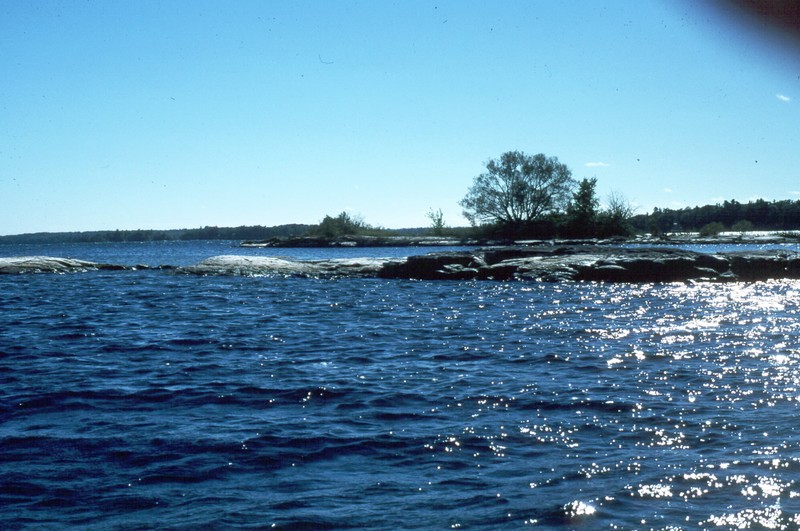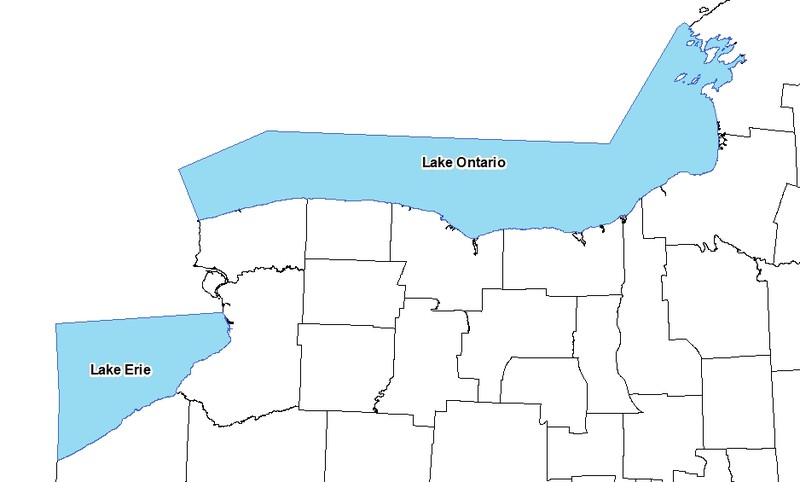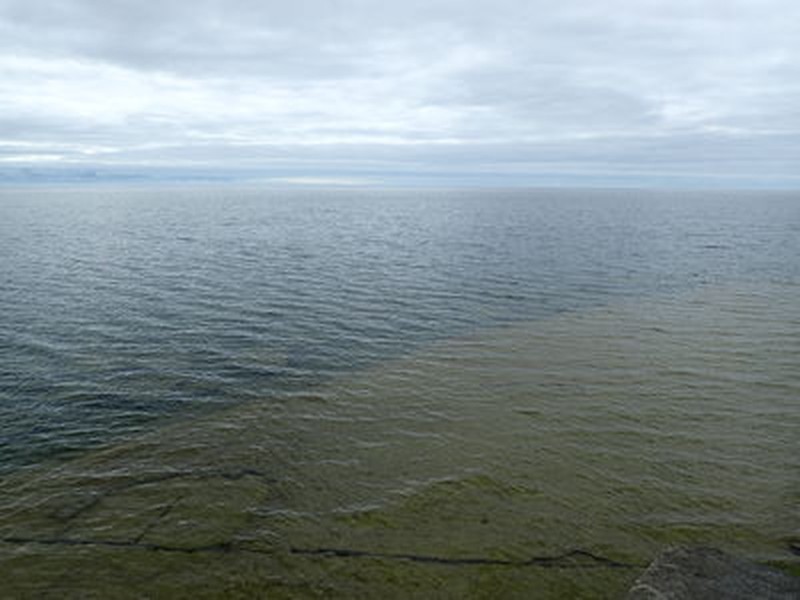Great Lakes Deepwater Community
- System
- Lacustrine
- Subsystem
- Natural Lakes And Ponds
- State Protection
- Not Listed
Not listed or protected by New York State.
- Federal Protection
- Not Listed
- State Conservation Status Rank
- S1S2
Critically Imperiled or Imperiled in New York - Especially or very vulnerable to disappearing from New York due to rarity or other factors; typically 20 or fewer populations or locations in New York, very few individuals, very restricted range, few remaining acres (or miles of stream), and/or steep declines. More information is needed to assign either S1 or S2.
- Global Conservation Status Rank
- G2G3
Imperiled or Vulnerable globally - At high or moderate risk of extinction due to rarity or other factors; typically 80 or fewer populations or locations in the world, few individuals, restricted range, few remaining acres (or miles of stream), and/or recent and widespread declines. More information is needed to assign either G2 or G3.
Summary
Did you know?
Surfing Lake Ontario is not only possible, it can be done year-round, if conditions are right to produce "seiches." Seiches are standing waves in bodies of water, and are often found in large lake systems during strong winds. The Great Lakes can produce waves big enough to seem like an ocean, but the waves are produced in a different manner. Lake waves are less powerful, come in shorter intervals and are far less consistent than ocean waves. Ocean waves are primarily created by offshore storms far from the beach, whereas lake waves are created by local winds. This distinction usually leaves experienced, well-prepared Great Lakes surfers to surf in the middle of storms to catch the best possible waves, where ocean surfers often surf on the fringe of larger storms.
State Ranking Justification
Only two occurrences in NY (Lake Ontario and Lake Erie) that have the physical setting to meet the minimum size and depth thresholds that define the community. The condition of these lakes are threatened by nutrient and pollution runoff; and numerous aquatic invasive species.
Short-term Trends
The number and acres of Great Lakes deepwater community in New York have likely remained stable in recent decades given that only Lake Ontario and Lake Erie have the physical setting to meet the minimum size and depth thresholds that define the community. However, the water quality of these lakes is threatened by excessive run-off of nutrients, pathogens, and toxins from the surrounding watershed; and they are also threatened by the spread of numerous aquatic invasive species.
Long-term Trends
The number and acres of Great Lakes deepwater community in New York are probably comparable to historical numbers, but the water quality of these lakes has likely declined significantly as a result of several human caused disturbances (e.g., nutrient and pollution run-off, invasive species, watershed development, etc.). New York's share of the Great Lakes has been significantly polluted and modified by introductions of non-native species; some introductions have resulted from migrations through the Welland and Erie canals. Non-native fishes of Lake Ontario include rudd (Scardinus erythrophthalmus), blueback herring (Alosa aestivalis), and round goby (Neogobius melanostomus). Many of the formerly common native fish have apparently disappeared from Lake Erie, or Lake Ontario, including blue pike (Stizostedion vitreum glaucum), bloater (Coregonus hoyi), kiyi (C. kiyi), shortnose cisco (C. reighardi), shortjaw cisco (C. zenithicus), and spoonhead sculpin (Cottus ricei).
Conservation and Management
Conservation Overview
Lakewide Action and Management Plans (or LAMPs) are plans of action to assess, restore, protect and monitor the ecosystem health of each Great Lake, including Lake Erie and Lake Ontario in New York State, in partnership with other states and Canada. General objectives identified in the Great Lakes Water Quality Agreement that guide LAMP efforts are as follows: 1. Be a source of safe, high quality drinking water. 2. Allow for unrestricted swimming and other recreational use. 3. Allow for unrestricted human consumption of fish and wildlife. 4. Be free from pollutants that could harm people, wildlife or organisms. 5. Support healthy and productive habitats to sustain our native species. 6. Be free from nutrients that promote unsightly algae or toxic blooms. 7. Be free from aquatic and terrestrial invasive species. 8. Be free from the harmful impacts of contaminated groundwater. 9. Be free from other substances, materials, or conditions that may negatively affect the Great Lakes. Look for more lake-specific information on this topic in the following management plans and reports: Lake Ontario Lakewide Action and Management Plan (Environment and Climate Change Canada and the U.S. Environmental Protection Agency 2018), Lake Erie Lakewide Action and Management Plan (Environment and Climate Change Canada and the U.S. Environmental Protection Agency 2019), and State of the Great Lakes 2019 Technical Report (Environment and Climate Change Canada and the U.S. Environmental Protection Agency 2021).
Threats
The water quality of these lakes is threatened by excessive run-off of nutrients, pathogens, and toxins from the surrounding watershed; and they are also threatened by the spread of numerous aquatic invasive species.
Lake Ontario: As indicated in the 2017 State of the Great Lakes Report, the overall health of Lake Ontario is fair and unchanging. Lake Ontario Lakewide Action and Management Plan, 2018-2022 has identified four priority threats to the waters of Lake Ontario including: 1) nutrient and bacterial-related impacts; 2) loss of habitat and native species; 3) invasive species; and 4) critical and emerging chemical contaminants. For more information see: Research needs to better understand Lake Ontario ecosystem function: A workshop summary (Stewart et al. 2016).
Lake Erie: The Lake Erie Lakewide Action and Management Plan, 2019-2023 has identified five priority threats to the waters of Lake Erie including: 1) nutrients and bacterial pollution; 2) chemical contaminant pollution; 3) loss of habitat and native species; 4) invasive species; and 5) climate change impacts. Lake Erie Ecosystem Priority (LEEP 2013): phosphorous loading, algal blooms, hypoxia, declining cold-water fish species and species sensitive to low oxygen and reduced water clarity.
Conservation Strategies and Management Practices
Reduce pollution, improve water quality, control exotic species. To implement the Lakewide Action and Management Plans and progress toward the achievement of the Great Lakes Water Quality Agreement general objectives within NY's portion of the Great Lakes, NYS agencies and partners are working on management actions, such as: restoring habitats for key species; controlling invasive species to reduce impacts; upgrading wastewater treatment infrastructure, and improving stormwater management using green infrastructure.
Development and Mitigation Considerations
To implement the LAMPs and progress toward the achievement of the Great Lakes Water Quality Agreement general objectives within NY's portion of the Great Lakes, NYS agencies and partners are working on management actions, such as: 1. restoring habitats for key species, 2. controlling invasive species to reduce impacts, 3. upgrading wastewater treatment infrastructure, and 4. improving stormwater management using green infrastructure. Look for more lake-specific information on this topic in the following management plans and reports: Lake Ontario Lakewide Action and Management Plan (Environment and Climate Change Canada and the U.S. Environmental Protection Agency 2018), Lake Erie Lakewide Action and Management Plan (Environment and Climate Change Canada and the U.S. Environmental Protection Agency 2019), and State of the Great Lakes 2019 Technical Report (Environment and Climate Change Canada and the U.S. Environmental Protection Agency 2021).
Inventory Needs
Collect inventory data from institutions or agencies working on Great Lakes ecosystems. Enter Lake Erie occurrence of this community into the NY Natural Heritage Program Biotics database.
Research Needs
Lake Erie: Accurate monitoring of phosphorous loading, identifying the most important sources, allows for effective priority-setting of actions to restore the health of Lake Erie. The 2013 Lake Erie Ecosystem Priority study identified gaps with respect to monitoring of phosphorous loading and its effects. These include an uneven distribution of tributary monitoring across the Lake Erie basin, very patchy monitoring of the lake’s nearshore zone, and a bias towards routine monitoring programs that may miss critical wet weather events – an issue of increasing importance under climate change. Knowledge gaps with respect to research include how different physical, chemical, and biological factors interact to create the conditions that can trigger harmful and nuisance algal blooms, how different fish communities of the lake may respond under the warming trends and altered precipitation patterns associated with continued climate change, how much various BMPs actually reduce phosphorous loading and how much they cost. In addition, there is a timely need for economic data that would allow for a better understanding of the economic impacts of algal blooms across the Lake Erie basin.
Lake Ontario: Research needs to better understand Lake Ontario ecosystem function: A workshop summary (Stewart et al. 2016).
Rare Species
- Lota lota (Burbot) (guide)
Range
New York State Distribution
Restricted to the Great Lakes along the western borders of the state. New York is at the eastern edge of range that extends west to Lake Superior's shore in Minnesota.
Global Distribution
This community is restricted to the Great Lakes basin in direct association with the Great Lakes. This range spans north and west to Lake Superior, Minnesota south to Lake Erie, Ohio and east to Lake Ontario, New York.
Best Places to See
- Lake Ontario (Lake Ontario Open Waters County)
- Lake Erie (Lake Erie Open Waters County)
Identification Comments
General Description
The open water community in any of the Great Lakes. In general, the Great Lakes are summer-stratified monomictic lakes: they usually do not freeze over in winter, they are mixed and isothermal in winter, and thermally stratified in summer (warmest water at the surface). One exception is that portions of eastern Lake Erie, along the New York shores, freeze over quite frequently. These lakes are primarily mesotrophic with eutrophic nearshore areas. Specialized habitats include nearshore fluvial deposits, deepwater reefs and trenches. The Great Lakes are distinguished from inland summer-stratified monomictic lakes because of their very large size and access to estuarine biota through the St. Lawrence River and Welland Canal. Lake Champlain is similar to this lake type. However, it is classified as a summer-stratified monomictic lake.
Characters Most Useful for Identification
This community includes the deepwater portions of Lake Ontario and Lake Erie.
Elevation Range
Known examples of this community have been found at elevations between -556 feet and 246 feet.
Best Time to See
New York's Great Lakes lakes can be easily observed from the shoreline where there is public access, or by boat during calm weather.
Great Lakes Deepwater Community Images
Classification
Characteristic Species
-
Unvegetated
- alewife (Alosa pseudoharengus)
- Atlantic salmon (Salmo salar)
- burbot (Lota lota)
- cisco (Coregonus artedii)
- deepwater sculpin (Myxocephalus thompsoni)
- emerald shiner (Notropis atherinoides)
- green algae (Cladophora spp.)
- lake chub (Couesius plumbeus)
- lake herring (Coregonus artedii)
- lake sturgeon (Acipenser fulvescens)
- lake trout (Salvelinus namaycush)
- lake whitefish (Coregonus clupeaformis)
- mooneye (Hiodon tergisus)
- oligochaete (Aulodrilus sp.)
- oligochaete (Potamothrix sp.)
- quillback (Carpiodes cyprinus)
- rainbow smelt (Osmerus mordax)
- round whitefish (Prosopium cylindraceum)
- silver chub (Hybopsis storeriana)
- slimy sculpin (Cottus cognatus)
- walleye (Stizostedion vitreum)
- white bass (Morone chrysops)
- white sucker (Catostomus commersoni)
- yellow perch (Perca flavescens)
- zooplankton - cladoceran (Bosmina longirostris)
- zooplankton - cladoceran (Daphnia retrocurva)
- zooplankton (Mysis relicta)
- zooplankton (Pontoporeia hoyi)
Similar Ecological Communities
- Summer-stratified monomictic lake
(guide)
Summer-stratified monomictic lakes are so deep (or large) that they have only one period of mixing or turnover each year (monomictic), and one period of stratification. These lakes generally do not freeze over in winter (except in unusually cold years), or form only a thin or sporadic ice cover during the coldest parts of midwinter, so the water circulates and is isothermal during the winter (similar temperature though the water column). These lakes are typically thermally stratified only in the summer (warmest water at the surface); they are oligotrophic to mesotrophic and alkaline. Characteristic aquatic macrophytes include pondweeds (Potamogeton gramineus, P. richardsonii, P. pectinatus), horned pondweed (Zannichellia palustris), naiad (Najas flexilis), waterweed (Elodea canadensis), tapegrass or wild celery (Vallisneria americana), and coontail (Ceratophyllum demersum). Great Lakes deepwater community: The open water community in any of the Great Lakes. In general, the Great Lakes are summer-stratified monomictic lakes: they usually do not freeze over in winter, they are mixed and isothermal in winter, and thermally stratified in summer (warmest water at the surface). One exception is that portions of eastern Lake Erie, along the New York shores, freeze over quite frequently. These lakes are primarily mesotrophic with eutrophic nearshore areas. Specialized habitats include nearshore fluvial deposits, deepwater reefs and trenches. The Great Lakes are distinguished from inland summer-stratified monomictic lakes because of their size and access to estuarine biota through the St. Lawrence River and Welland Canal. Lake Champlain is similar to this lake type. However, it is classified as a summer-stratified monomictic lake.
- Winter-stratified monomictic lake
(guide)
Winter-stratified monomictic lakes have only one period of mixing each year because they are very shallow in relation to its size and is completely exposed to winds. These lakes continue to circulate throughout the summer and typically never become thermally stratified in that season. They are only stratified in the winter when they freeze over and become inversely stratified (coldest water at the surface). They are eutrophic to mesotrophic. Littoral, and epilimnion species assemblages predominate. Pelagic species assemblages are well developed. Vascular plants are typically diverse. Characteristic aquatic macrophytes include water stargrass (Heteranthera dubia), coontail (Ceratophyllum demersum), waterweed (Elodea spp.), naiad (Najas flexilis), tapegrass (Vallisneria americana), and pondweeds (Potamogeton perfoliatus, P. pectinatus, P. pusillus, P. richardsonii, P. nodosus, P. zosteriformis). The macroalgae Chara may be abundant. Great Lakes deepwater community: The open water community in any of the Great Lakes. In general, the Great Lakes are summer-stratified monomictic lakes: they usually do not freeze over in winter, they are mixed and isothermal in winter, and thermally stratified in summer (warmest water at the surface). One exception is that portions of eastern Lake Erie, along the New York shores, freeze over quite frequently. These lakes are primarily mesotrophic with eutrophic nearshore areas. Specialized habitats include nearshore fluvial deposits, deepwater reefs and trenches. The Great Lakes are distinguished from inland summer-stratified monomictic lakes because of their size and access to estuarine biota through the St. Lawrence River and Welland Canal. Lake Champlain is similar to this lake type. However, it is classified as a summer-stratified monomictic lake.
Additional Resources
References
Edinger, G. J., D. J. Evans, S. Gebauer, T. G. Howard, D. M. Hunt, and A. M. Olivero (editors). 2014. Ecological Communities of New York State. Second Edition. A revised and expanded edition of Carol Reschke’s Ecological Communities of New York State. New York Natural Heritage Program, New York State Department of Environmental Conservation, Albany, NY. https://www.nynhp.org/ecological-communities/
Edinger, Gregory J., D.J. Evans, Shane Gebauer, Timothy G. Howard, David M. Hunt, and Adele M. Olivero (editors). 2002. Ecological Communities of New York State. Second Edition. A revised and expanded edition of Carol Reschke's Ecological Communities of New York State. (Draft for review). New York Natural Heritage Program, New York State Department of Environmental Conservation. Albany, NY. 136 pp.
Environment and Climate Change Canada and the U.S. Environmental Protection Agency. 2018. Lake Ontario Lakewide Action and Management Plan, 2018-2022.
Environment and Climate Change Canada and the U.S. Environmental Protection Agency. 2019. Lake Erie Lakewide Action and Management Plan, 2019-2023.
Environment and Climate Change Canada and the U.S. Environmental Protection Agency. 2021. State of the Great Lakes 2019 Technical Report. Cat No. En161- 3/1E-PDF. EPA 905-R-20-044. Available at binational.net.
New York Natural Heritage Program. 2024. New York Natural Heritage Program Databases. Albany, NY.
Reschke, Carol. 1990. Ecological communities of New York State. New York Natural Heritage Program, New York State Department of Environmental Conservation. Latham, NY. 96 pp. plus xi.
Stewart, Thomas J., Lars Rudstam, James Watkins, Timothy B. Johnson, Brian Weidel, and Marten A. Koops. 2016. Research needs to better understand Lake Ontario ecosystem function: A workshop summary. Journal of Great Lakes Research. 42(1):1-5.
Links
About This Guide
This guide was authored by: Gregory J. Edinger
Information for this guide was last updated on: December 5, 2023
Please cite this page as:
New York Natural Heritage Program. 2024.
Online Conservation Guide for
Great Lakes deepwater community.
Available from: https://guides.nynhp.org/great-lakes-deepwater-community/.
Accessed July 26, 2024.




